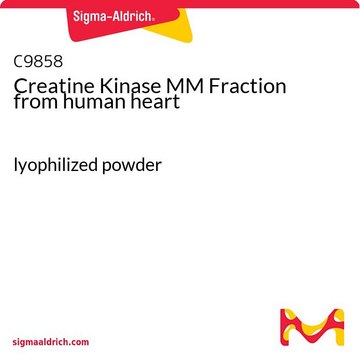D5891
1,1-Dimethyl-4-phenylpiperazinium iodide
≥98% (TLC or titration)
Sinónimos:
DMPP
About This Item
Productos recomendados
Nivel de calidad
Ensayo
≥98% (TLC or titration)
Formulario
powder
mp
234-238 °C (lit.)
solubilidad
H2O: 21 mg/mL
temp. de almacenamiento
−20°C
cadena SMILES
[I-].C[N+]1(C)CCN(CC1)c2ccccc2
InChI
1S/C12H19N2.HI/c1-14(2)10-8-13(9-11-14)12-6-4-3-5-7-12;/h3-7H,8-11H2,1-2H3;1H/q+1;/p-1
Clave InChI
XFZJGFIKQCCLGK-UHFFFAOYSA-M
Información sobre el gen
human ... CHRNA1(1134) , CHRNA10(57053) , CHRNA2(1135) , CHRNA3(1136) , CHRNA4(1137) , CHRNA5(1138) , CHRNA6(8973) , CHRNA7(1139) , CHRNA9(55584) , CHRNB1(1140) , CHRNB2(1141) , CHRNB3(1142) , CHRNB4(1143)
rat ... Chrna2(170945) , Chrna3(25101) , Chrna4(25590) , Chrnb2(54239) , Chrnb4(25103)
¿Está buscando productos similares? Visita Guía de comparación de productos
Aplicación
- to study the roles of α7 and α4β2 nAchRs in autonomic regulation of cardiovascular responses in urethane-anesthetized mice
- to study the mechanism involved in improving glucose tolerance in diet-induced obese (DIO) mice treated with DMPP
- to study its pharmacological effect on enteric viscerofugal neurons in the myenteric plexus of guinea-pig colon
Acciones bioquímicas o fisiológicas
Características y beneficios
Código de clase de almacenamiento
11 - Combustible Solids
Clase de riesgo para el agua (WGK)
WGK 3
Punto de inflamabilidad (°F)
Not applicable
Punto de inflamabilidad (°C)
Not applicable
Equipo de protección personal
dust mask type N95 (US), Eyeshields, Gloves
Elija entre una de las versiones más recientes:
¿Ya tiene este producto?
Encuentre la documentación para los productos que ha comprado recientemente en la Biblioteca de documentos.
Nuestro equipo de científicos tiene experiencia en todas las áreas de investigación: Ciencias de la vida, Ciencia de los materiales, Síntesis química, Cromatografía, Analítica y muchas otras.
Póngase en contacto con el Servicio técnico








